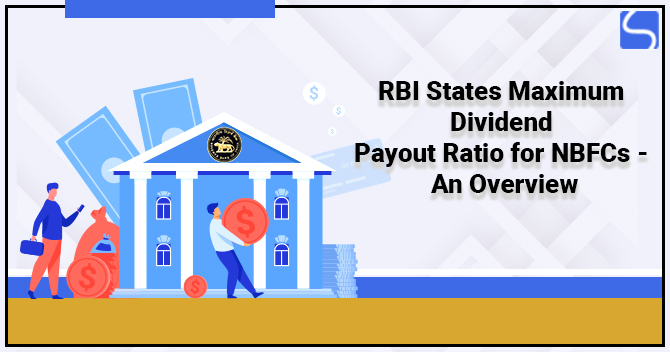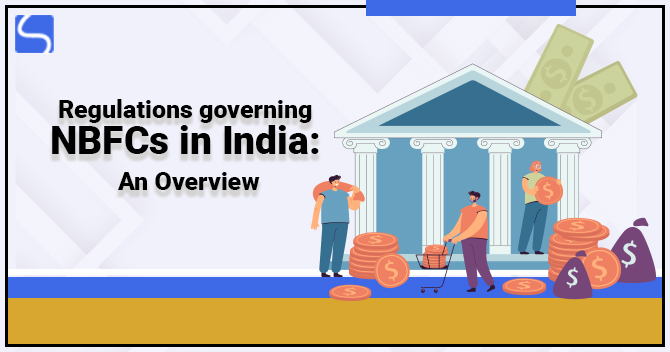The RBI States Maximum Dividend Payout Ratio for NBFCs – An Overview

Karan Singh | Updated: Jul 05, 2021 | Category: NBFC, RBI Advisory
The RBI (Reserve Bank of India) released guidelines that state the criteria for NBFCs to declare dividends. The RBI (Reserve Bank of India) claimed that the new rules are framed with an outlook to impart better consistency and transparency in practice. In this blog, we shall discuss the significant details of the notification released by the Reserve Bank of India on the maximum dividend payout ratio for NBFCs (Non-Banking Financial Companies).
Table of Contents
Fundamentals While Assessing an Offer for Dividend announcements
The BODs (Board of Directors) of such firms are needed to make sure that they consider the following while assessing the offer for dividend announcements:
- National Housing Bank and RBI’s supervisory findings on divergence in categorisation and provisioning for NPA (Non-Performing Assets);
- Long-term development plan of NBFCs;
- Qualifications in the report of the auditor to financial statements.
Eligibility Criteria for Dividend Payment: Maximum Dividend Payout Ratio for NBFCs
The Non-Banking Financial Companies (NBFCs) and Housing Finance Companies (HFCs) are also required to execute specific benchmarks to meet the criteria for a dividend payment. The standards comprise the following criteria:
- Total Non-Performing Asset Ratio is less than 6% of the past three years, consisting of the year when the dividend is announced;
- Minimum capital requirements are fulfilled for the previous three financial years;
- No explicit limitations from the Reserve Bank of India or National Housing Bank on announcing dividends.
Maximum Dividend Payout Ratio for Non-Banking Financial Companies: Quantum for Dividend Payable
The RBI (Reserve Bank of India) also declared a top limit for dividend payout ratios. This ratio means the ratio between the total dividend payable and the total profit for a financial year. The upper limit for the dividend payout ratio declared by the Reserve Bank of India is mentioned in the table below:
| Types of NBFCs | % of Maximum Dividend Payout Ratio |
| Non-Banking Financial Companies that don’t accept any public funds and not having any client interface. | No Upper Limit |
| Standalone Primary Dealers | 60% |
| Core Investment Companies | 60% |
| Other Non-Banking Financial Companies | 50% |
- Non-Banking Financial Companies that don’t accept any public funds and not having any client interface, no Maximum Dividend Payout Ratio (Ceiling) has prescribed;
- In the case of other Non-Banking Financial Companies, the dividend payout ratio is completed at 50%;
- The maximum Dividend Payout Ratio for CIC (Core Investment Companies) and unconnected with primary dealers is set at 60%.
It is worth introducing here that the regulator described that the total dividend payable must comprise payments on equity shares and those on obligatory convertible preference shares eligible for inclusion in Tier 1 capital.
NBFCs that didn’t fulfil the minimum financial standards mentioned above can be qualified to announce a dividend, subject to a cap of 10% on the dividend payout ratio if they fulfil the condition as mentioned below:
- Fulfils applicable capital sufficiency necessity for the year where they propose to declare the dividend;
- Has the total Non-Performing Asset ratio less than 4% at the end of the Financial Year.
The Reserve Bank of India mentioned that in the case of separate primary dealers which have the Capital Adequacy Ratio of 15% (Regulatory Minimum) or above at the time3 of each of the quarters of the last year, but less than 20% in any of those quarters, the dividend payout ratio cannot exceed 33.3%.
What is the Purpose of the RBI Guidelines?
The Reserve Bank of India set the Maximum Dividend Payout Ratio as a part of RBI guidelines[1] on the dispensation of dividends by NBFCs (Non-Banking Financial Companies). As per the RBI (Reserve Bank of India), the guidelines are focused on covering infusing greater transparency and consistency in the payout practice and will be helpful for the declaration of dividends from the financial year ending 31st March 2022.
Such guidelines of the Reserve Bank of India were proposed 1st by the Reserve Bank of India (RBI) in the form of a draft circular in the December month previous year and came after the Reserve Bank of India governor Shaktikanta Das on 4th December mentioned that the growing importance of Non-Banking Financial Companies and their inter-linkages with different areas in the financial system. The governor of the RBI (Reserve Bank of India) had said that it made essential to boost the flexibility of the sector.
The governor has said that it had been decided to put in place transparent criteria according to the matrix of parameters for the declaration of dividends by various categories of NBFCs.
Conclusion
The strengthening in dividend payout rules comes with a few weeks of the norms of the Reserve Bank of India on auditor appointments. Non-Banking Financial Companies are against the progress of auditor appointments, but the Reserve Bank of India has remained adamant. For a good understanding, you may also refer to the notification of the Reserve Bank of India on Maximum Dividend Payout Ratio for Non-Banking Financial Companies attached with this blog.
NBFCS2A8A6D0DFCD346B7BA78285EE25759A6-1













